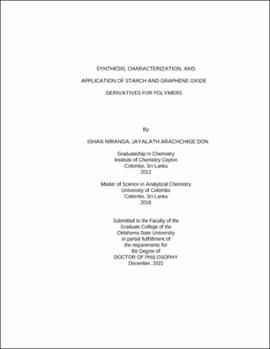| dc.contributor.advisor | Blum, Frank D. | |
| dc.contributor.author | Jayalath Arachchige Don, Ishan Niranga | |
| dc.date.accessioned | 2023-07-05T20:56:36Z | |
| dc.date.available | 2023-07-05T20:56:36Z | |
| dc.date.issued | 2022-12 | |
| dc.identifier.uri | https://hdl.handle.net/11244/337853 | |
| dc.description.abstract | Graphene oxide (GO) and starch have often been tested for use as fillers, additives, and interfacial modifiers for polymer composites. However, using pristine GO and starch has several drawbacks, including dispersion constraints resulting in incompatibility with hydrophobic polymers, low reactivity, and agglomerations. To overcome these drawbacks, GO and starch can be chemically modified to increase their compatibility with polymers to meet the requirements for various applications. | |
| dc.description.abstract | Polyhedral oligomeric silsesquioxane (POSS) is a class of molecules with good potential as a modifier for starch and GO. However, limited attention has been paid to using POSS-modified starch and GO as an additive or filler for polymers. Once grafted to the starch and GO, aminopropylisobutyl POSS (POSS-NH₂) is a hydrophobic molecule that can play an important role in composite materials. This family of molecules can increase the hydrophobic characteristics of starch and GO by breaking internal hydrogen bonds and facilitating effective dispersion in the a wider variety of resins. Once a filler has been mixed with resin, the van der Waals attractions between the isobutyl groups and the resin improve the dispersion, which yields improved mechanical properties, including strength, modulus, and toughness. The silica core is a cage that can act as a “heat sink”, reducing the thermal conduction in the composites and increasing its thermal stability. POSS-modified starch and GO were characterized using ¹H NMR, FT-IR spectroscopy, thermogravimetric analysis, X-Ray diffraction analysis (XRD) and elemental analysis. The chemically modified materials were dispersed in epoxy resin using a shear mixer that is feasible for use in industrial setups. The thermo-mechanical properties of the neat and filler/additive-loaded resins were studied as a function of different filler/additive loadings using a dynamic mechanical analyzer (DMA). | |
| dc.description.abstract | The interphase between reduced graphene oxide (rGO) and polyvinyl pyrrolidone (PVP) is critical in the behavior of its composites. The thermal behavior of PVP on rGO suggested that a tightly bound polymer existed on the rGO surface that had a much broader glass transition compared to the bulk polymer. The quantification of this polymer fraction suggests that the amount of tightly bound polymer on the rGO was approximately 0.84 mg PVP/m² rGO surface. | |
| dc.format | application/pdf | |
| dc.language | en_US | |
| dc.rights | Copyright is held by the author who has granted the Oklahoma State University Library the non-exclusive right to share this material in its institutional repository. Contact Digital Library Services at lib-dls@okstate.edu or 405-744-9161 for the permission policy on the use, reproduction or distribution of this material. | |
| dc.title | Synthesis, characterization, and application of starch and graphene oxide derivatives for polymers | |
| dc.contributor.committeeMember | Cook, Gabriel | |
| dc.contributor.committeeMember | Fennell, Christopher J. | |
| dc.contributor.committeeMember | Vaidyanathan, Ranji K. | |
| dc.contributor.committeeMember | White, Jeffery L. | |
| osu.filename | Jayalatharachchigedon_okstate_0664D_17996.pdf | |
| osu.accesstype | Open Access | |
| dc.type.genre | Dissertation | |
| dc.type.material | Text | |
| dc.subject.keywords | additives | |
| dc.subject.keywords | epoxy | |
| dc.subject.keywords | graphene oxide | |
| dc.subject.keywords | hydrophobic | |
| dc.subject.keywords | mechanical properties | |
| dc.subject.keywords | starch | |
| thesis.degree.discipline | Chemistry | |
| thesis.degree.grantor | Oklahoma State University | |
